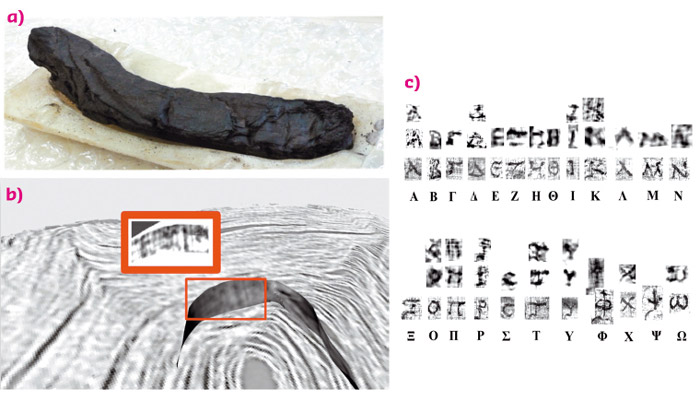- Home
- Users & Science
- Scientific Documentation
- ESRF Highlights
- ESRF Highlights 2015
- Complex systems and biomedical sciences
- Ancient scrolls charred by the eruption of Mount Vesuvius unveil some of their secrets
Ancient scrolls charred by the eruption of Mount Vesuvius unveil some of their secrets
Writing that has lain undiscovered for centuries inside a scroll blackened as a consequence of the eruption of Mount Vesuvius in 79 AD has been uncovered for the first time. The text written inside a so called ‘papyrus roll’ of the only surviving library from Antiquity, has been partly deciphered in a computed tomography experiment.
The explosion of Vesuvius in 79 AD, destroyed several Roman towns in Campania, especially Pompeii and Herculaneum. After the first discovery of papyrus rolls in 1752, an entire library was discovered in 1754 inside a small room of a huge villa containing hundreds of handwritten carbonised papyrus scrolls carefully stored in shelves covering its walls. These philosophical and literary texts have remained a mystery to scholars.
Many attempts have been made to look at the texts inside the scrolls in order to acquire more knowledge about ancient (presumably Greek) literature and philosophy. The main problem has, however, been that the scrolls are easily damaged by attempts to unroll them. Moreover, the carbonised papyri and the black ink have a similar composition: papyri were written using a black carbon-based ink obtained from smoke residues, the density of which is almost the same as that of the charred papyrus. This has been one of the reasons for the failure during previous non-destructive attempts to unveil the texts using conventional X-ray techniques [1].
Two scrolls were examined (one unrolled and the other still unopened), which had been presented as a ‘gift’ to the Premier Consul Napoléon Bonaparte in 1802 and currently belonging to the collection of the Institut de France. The first sample is a fragment of the unrolled scroll, PHerc.Paris. 1, while the second (PHerc.Paris. 4) is an entirely rolled-up scroll. Our results show that X-ray phase contrast tomography, performed at beamline ID17, is the first non-destructive technique that enables many Greek letters and some words inside the windings of rolled-up Herculaneum papyri to be recovered without impairing their physical integrity. This is extremely important because the fragility of carbonised papyri hampers mechanical unfolding, even with the most careful manipulation.
 |
|
Fig. 95: (a) Hidden layer of fragment 101 from PHerc.Paris.1 and two sequences of Greek capital letters from within it: (b) ΠΙΠTOIE; (c) ΕΙΠΟΙ. |
An initial experiment was performed on a very small part of fragment 101 from PHerc.Paris. 1. In Figure 95a, a hidden papyrus layer is shown where a sequence of letters are clearly distinguishable. In Figure 95b, the sequence of Greek capital letters ΠΙΠTOIE (pi-iota-pi-tau-omicron-iota-epsilon), could be recovered. This word means ‘would fall’. In Figure 95b, it is possible to read another sequence of letters, almost certainly ΕΙΠΟΙ (epsilon-iota-pi-omicron-iota), meaning ‘would say’.
 |
|
Fig. 96: (a) Photograph of the Herculaneum papyrus scroll PHerc.Paris.4. (b) Extraction of a sequence of letters from within the scroll. (c) Recovered alphabet from different locations in the scroll. |
The main object of the investigation was a nearly complete scroll that is typical of rolled-up Herculaneum papyri (Figure 96a). The tremendous pressure of the pyroclastic material compressed the scroll and deformed its internal spiral structure, the windings of which are folded in a nearly chaotic entangled fashion. As a consequence, the letters are more or less badly distorted, since they lie on highly non-planar surfaces that are cut by selected planar sections for rendering purposes. All this makes data analysis a formidable challenge, since it is necessary to ascertain the phase contrast associated with the text on a surface, the shape and topology of which exhibit an extremely high degree of complexity. Despite these difficulties, we were able to discern evidence of contrast in the reconstruction (see Figure 96b). An almost entire alphabet recovered from this sample is presented in Figure 96c. It comes from different images of the scroll acquired during the experimental scans. In the figure, the 24 letters of the Greek alphabets are arranged in three superimposed lines. Lines 1 and 2 consist of letters taken from several internal regions of the sample. Line 3 contains infrared images of the same letters from an unrolled papyrus (PHerc. 1471), which was used as a reference for the writing style of the period.
The discovery that phase contrast computed tomography can recover writing inside carbonised papyrus rolls has an impact that reaches far beyond the study of one particular Herculaneum papyrus. Many philosophical works from the library of the ‘Villa dei Papiri’ could potentially be deciphered without damaging the papyrus in any way. Moreover, the phase contrast technique offers exciting new and unexpected prospects for application to other unreadable ancient texts.
Principal publication and authors
V. Mocella (a), E. Brun (b,c), C. Ferrero (b) and D. Delattre (d), Nature Comm 6, 5895 (2015); doi: 10.1038/ncomms6895.
(a) CNR-IMM-Istituto per la Microelettronica e Microsistemi-Unità di Napoli, Napoli (Italy)
(b) ESRF
(c) Ludwig-Maximilian-Universität, Garching bei München (Germany)
(d) CNRS-IRHT-Institut de Recherche et d’Histoire des Textes, Paris (France)
References
[1] W.B. Seales and D. Delattre, Cronache Ercolanesi 43, 191–208 (2013).



